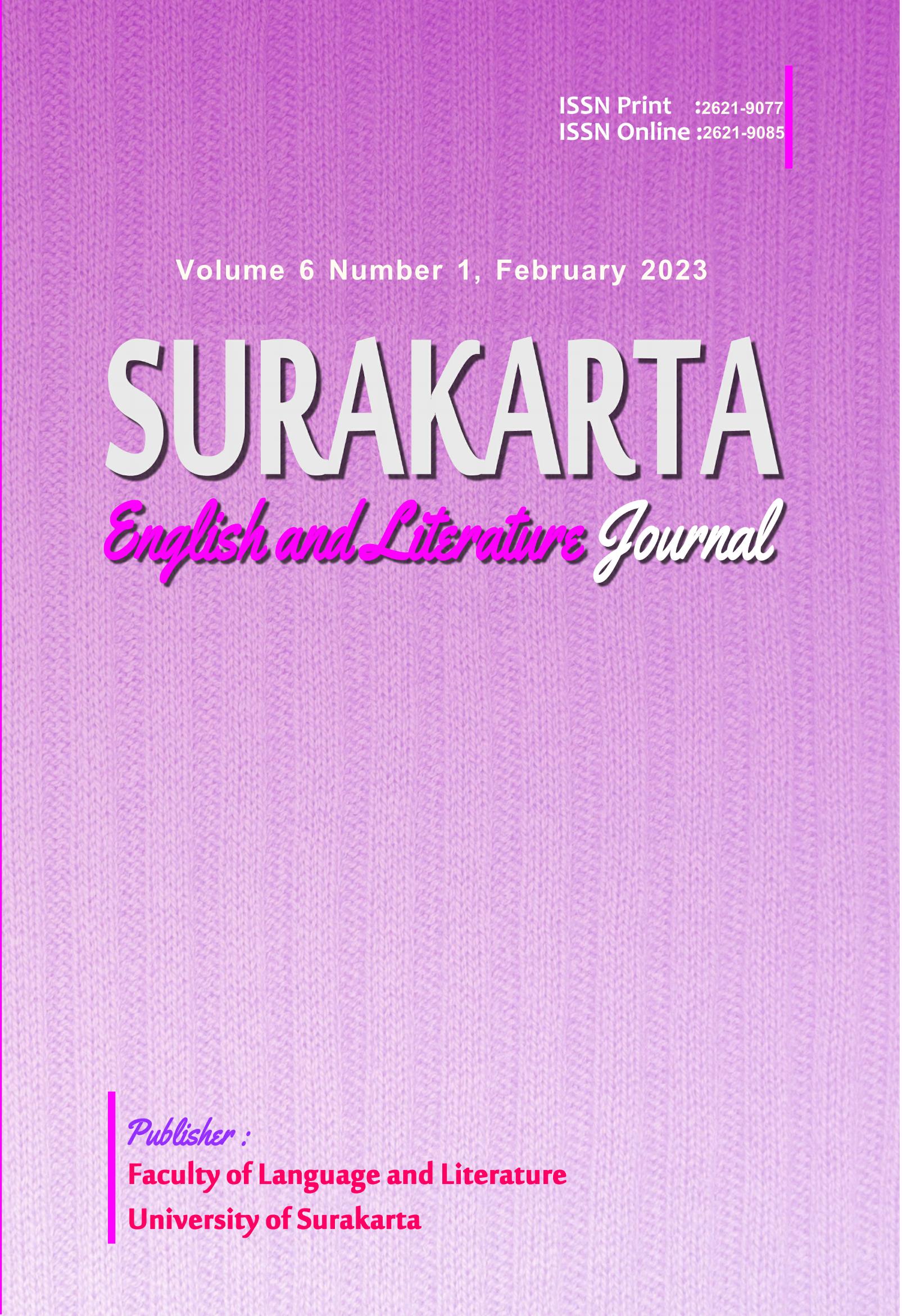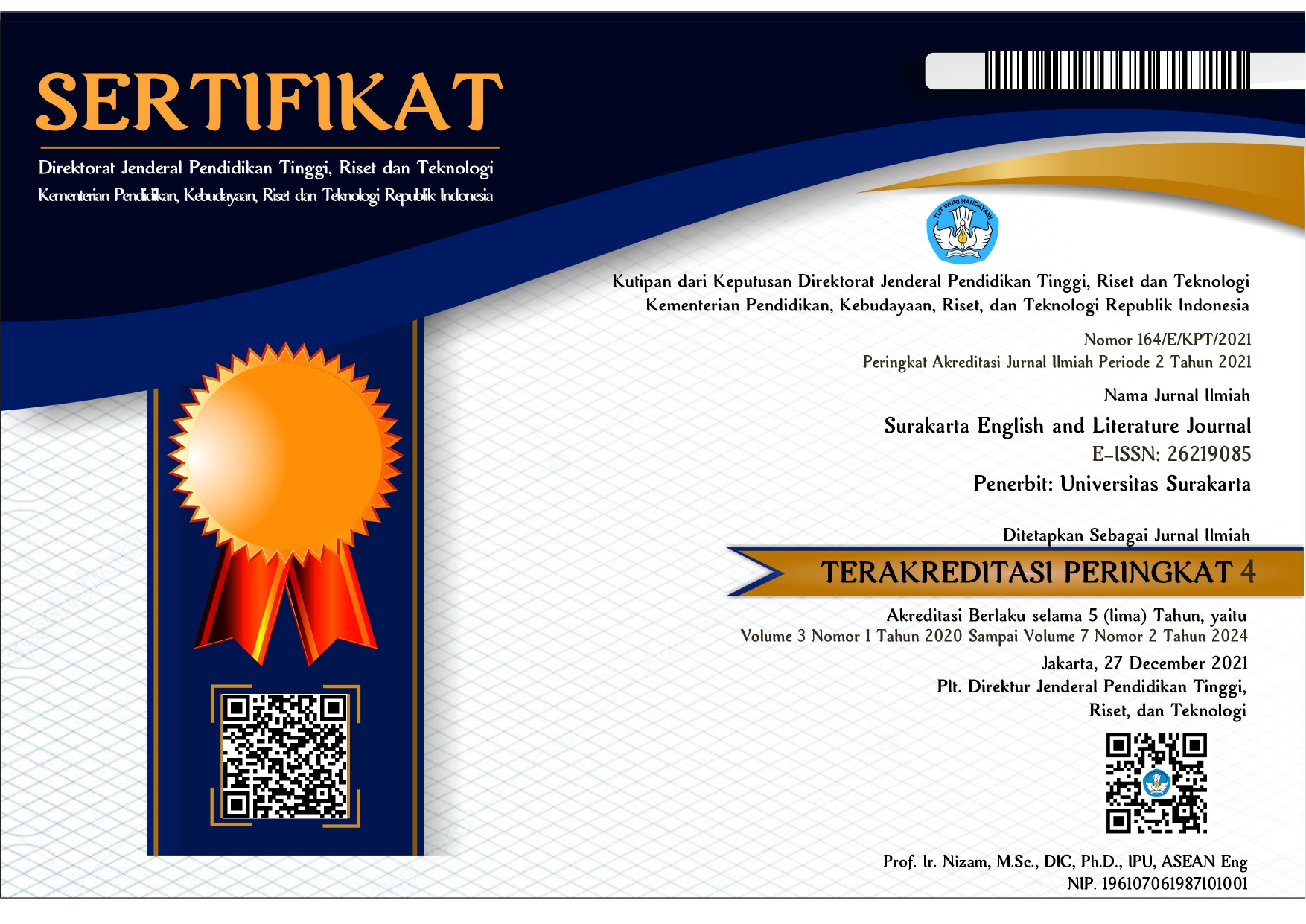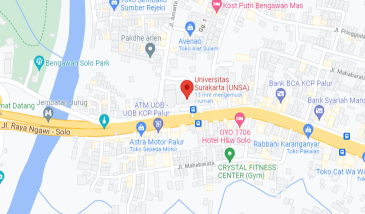A Contrastive Study on Indonesian and English Question Words
DOI:
https://doi.org/10.52429/selju.v6i1.87Keywords:
contrastive analysis, interrogative, and translationAbstract
Interrogative sentences constitute one of the most important modes of sentences in any world language. By this type of sentence, the language speakers can get information regarding everything they do not know, something they hesitate, or anything that the hearer wants to agree with. As such, this mode of sentence should be mastered by all language learners. However, like any other mode of sentences, interrogative sentences are also differently structured across languages, bringing serious difficulties for all second language learners. Moreover, languages do not belong to the same family group, like Indonesian, which belongs to the Austronesian family group, and English, which belongs to the Indo-German family group. Concerning this matter, this research paper will briefly describe the differences in the use of Indonesian question words apa, siapa, berapa, di mana, bagaimana,and kapan and its English contrast with what, who, how many/much, where and when. By contrasting Indonesian interrogative sentences containing apa, siapa, berapa, di mana, bagaimana, and kapan, and how they are expressed in English, it is found that not all these Indonesian question words can be directly and translated into what, who, how many/much, where and when. These differences will hopefully enhanche awareness of all language learners about the individualities or peculiarities owned by any language to ease their learning processes.
References
Amfo, N. A. A., & Fretheim, T. (2008). ’Abroad’and Semantically Related Terms in Some European Languages and Akan. In: Languages and Cultures in Contrast and Comparison, edited by Maria de los Angeles Gomez-Gonzalez, Lachlan Mackenzie and Elsa Gonzalez-Alvarez.
Brown, H. D. (1980). Principles of Languange Learning and Teaching. Prentice Hall.
Dardjowidjojo, S. (1986). Bentuk pasif sebagai cermin pikiran bangsa Indonesia. Dalam Pusparagam Linguistik& Pengajaran Bahasa. Bambang Kaswanti Purwo (Ed). Jakarta: Arcan.
Duranti, A. (1997). Universal and culture-specific properties of greetings. Journal of Linguistic Anthropology, 7(1), 63–97.
Effendi, T. D. (2016). Bahasa Indonesia Diplomacy and Other Country Language Diplomacy Experiences. Global Journal of Politics and Law Research, 4(3), 21–28.
Fajri, A. D. (2012). A Contrastive Analysis of Indonesian and English Noun Phrases: How the Differences Create Problems in Translation as Seen in “Chemistry 2A for Senior High School Grade XI Semester 1.” Lexicon, 1(2), 122–138.
Gundel, J. K. (2008). Contrastive perspectives on cleft sentences. Languages and Cultures in Contrast and Comparison, 69–89.
Humaira, L. (2015). A Contrastive Analysis between English and Indonesian General Sentences Pattern.
Hutahaean, D. T. (2019). A Contrastive Analysis between English and Indonesia in Novel. Journal of English Teaching As a Foreign Language, 5(1), 71–80.
Kaplan, R. B. (1966). Cultural thought patterns in inter-cultural education. Language Learning, 16(1–2), 1–20.
Kusumawati, A. (2019). Contrastive Analysis between Indonesian and English Declarative sentences. IAIN Syarif Hidayatullah.
Machali, R. (2000). Pedoman Bagi Penerjemah Jakarta: PT Grasindo. WOO.
Magnus, I. (2008). The position of adverbials and the pragmatic organization of the sentence. Pragmatics & Beyond New Series (P&BNS).
Mena, V. V., & Saputri, K. (2018). A contrastive analysis between English and Indonesian prefixes and suffixes in the descriptive texts of student’s textbooks. English Community Journal, 2(1), 175–182.
Muliastuti, L. (2017). Bahasa Indonesia bagi penutur asing: acuan teori dan pendekatan pengajaran. Yayasan Pustaka Obor Indonesia.
Newmark, P. (1988). A Textbook of Translation. Prentice-hall.
Pravitasari, S. G. (2022). Error Analysis on Efl Students’ Essay Writing (Fourth Semester Students of STMIK Sinar Nusantara Surakarta). Surakarta English and Literature Journal, 5(1), 13–25.
Richards, J., Platt, J., & Weber, H. (1985). terjemahan Longman Dictionary Of Applied Linguistics. Harlow, Essex, England: Longman.
Sulaiman, M. (2018). A contrastive analysis between english and indonesian pronominals. English Empower: Journal of Linguistics and Literature, 3(2), 82–91.
Uktolseja, L. J., Sujaja, H., & Matinahoru, M. F. (2019). A Contrastive Analysis between English and Indonesian Kinds of Sentences. IJET (Indonesian Journal of English Teaching), 8 (1), 54--61. IJET, 1(8), 54–61.
Utami, F. R. . (2009). Contrastive Analysis between English and Indonesian Basic sentence patterns. Semarang State University.
Wenguo, P., & Mun, T. W. (2007). Contrastive linguistics: history, philosophy and methodology. Continuum.
Whorf, B. L. (2012). Language, thought, and reality: Selected writings of Benjamin Lee Whorf (J. B. C. (Ed.). (ed.)). MIT press.
Wijana, I. D. P. (2022a). Expressing Times in Indonesian and English: A Contrastive Study. BATARA DIDI: English Language Journal, 1(1), 58–67.
Wijana, I. D. P. (2022b). Indonesian Passive and English Active Perspective: Problems for The Learners of Both Languages. Linguistic Issues: A Compilation of Working Papers. TS Publisher.
Wijana, I. D. P. (2022c). Me(n)- and ber- in Indonesian. Linguistic Issues: A Compilation of Working Papers. A. Com Press.

Downloads
Published
How to Cite
Issue
Section
License
Copyright (c) 2023 I Dewa Putu Wijana

This work is licensed under a Creative Commons Attribution-ShareAlike 4.0 International License.
Licensing for Data Publication
-
Open Data Commons Attribution License, http://www.opendatacommons.org/licenses/by/1.0/ (default)
-
Creative Commons CC-Zero Waiver, http://creativecommons.org/publicdomain/zero/1.0/
-
Open Data Commons Public Domain Dedication and Licence, http://www.opendatacommons.org/licenses/pddl/1-0/













